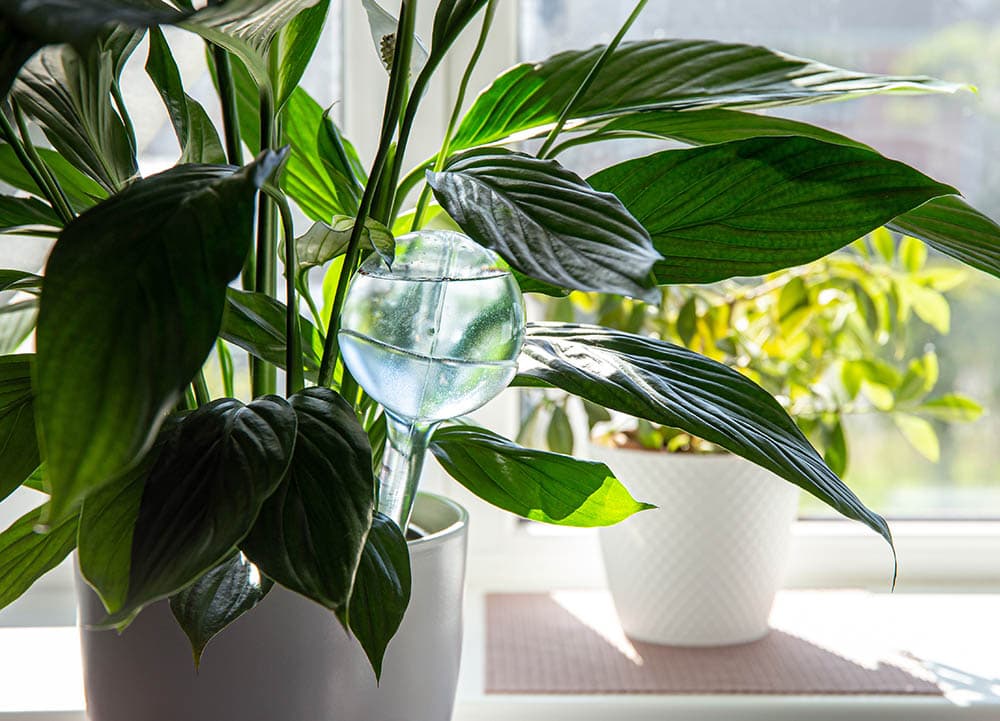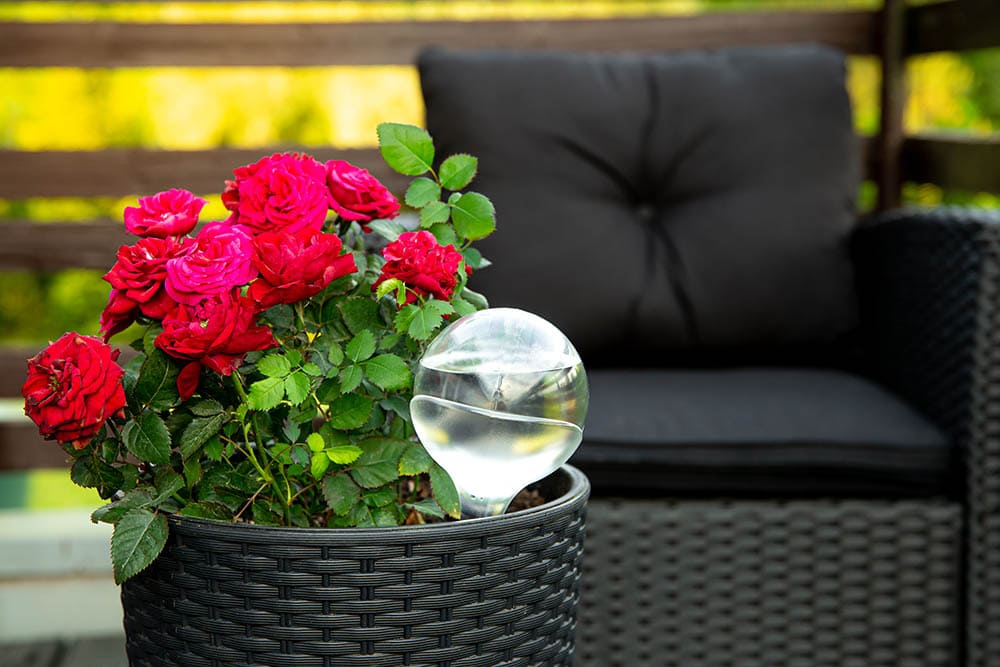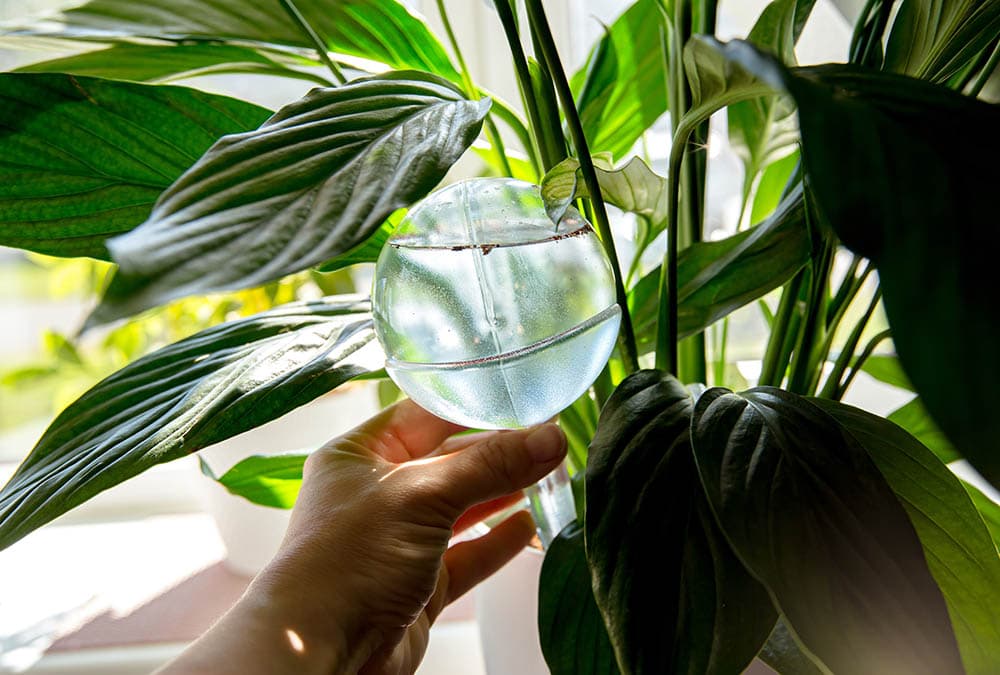Do Watering Globes Work? Pros, Cons & FAQ
-

- Last updated:

A watering globe is designed to water your plants for you. The idea is that these globes create a seal while watering the soil. This seal prevents too much water from coming out at a time. Although watering globes sound great in theory, do they really work?
In short, watering globes work if you use them properly. You have to be diligent in replacing the water in the globe, or else the globe will eventually run out of water and fail to do its job. Not to mention, watering globes aren’t right for all plants.
Keep reading to find out more, such as a comprehensive explanation of how watering globes work and their pros and cons.
How Do Watering Globes Work?
Watering globes are considered a self-watering system. This system is a lot more affordable than purchasing a comprehensive water system on a timer. How exactly does this technology work?
To understand how watering globes work, you have to understand their parts. Watering globes contain a hollow sphere on top of a hollow stem. Often, watering globes are made from blown glass so they can have an attractive appearance.
In order to use the globe, you will fill it up with water and stick it in the soil. Although you might think that all the water will flow out—this is not the case. Watering globes have been specifically designed so that water is released only when air can be displaced inside the globe. This only occurs whenever the soil needs to be watered again.
When water trickles out of the stem, a weak vacuum is created inside the globe. This vacuum slows the rate of liquid escaping. Once the soil gets saturated, air will not get up the stem and displace the water in the bulb. Thus, the globe stops watering the soil. Only once the soil is dry will air displace the water and cause the bulb to continue watering again.

Does It Really Work?
So, do watering globes really work? Yes and no.
The technology behind watering globes really does work. Especially if you install the watering globe correctly, you can rely on the watering globe to water your plant effectively.
However, watering globes are not an effective watering solution for all plants, despite working as it claims. It’s important that you only use watering globes on plants that need consistently moist soil. Cacti, succulents, and other plants that need dry soil will largely die from the excess moisture caused by the watering globe.
In other words, watering globes really do work as they say, but they might not be the best watering system based on the plant you are trying to care for.
Where Is It Used?
Watering globes are primarily used for indoor plants that need consistently moist soil.
Because watering globes constantly release water when the soil gets dry, the watering globe will ensure that your plant gets moist water all the time. Indoor plants like palms, for example, thrive with watering globes since these plants require constantly moist soil.
Watering globes are mainly only used inside since these objects are normally made from blown glass. Blown glass can be broken easily, which means watering globes aren’t always ideal for outdoor scenarios. That being said, watering globes will work just as effectively outdoors as indoors. You might have to buy new watering globes if used outside, though.

Advantages of Watering Globes
The biggest advantage of watering globes is that you don’t have to manually water your plants. Any plant parent knows that plants that need consistently moist soil can be a burden to take care of. With watering globes, you don’t have to water the plant every day. Instead, you may only need to refill the watering globe every week or so.
Furthermore, watering globes are also advantageous if you are going on vacation. Instead of hiring someone to come over and water your plants every day, you can stick a watering globe in the ground to ensure the plants get the water they need.
Another advantage to watering globes is that they are breathtaking. Because of the blown glass material, watering globes are beautiful and pair wonderfully with other plants. As such, watering globes can even add more color and life to your potted garden.
Disadvantages of Watering Globes
Even though there are several benefits of watering globes, there are some downsides as well. Most notably, watering globes are not an option for plants that need dry soil. Due to the technology of watering globes, the plant will likely be bogged down with excess water if it needs dry soil conditions.
Another downside to a watering globe is that they are difficult to fill up and insert. Because the stem is so much thinner than the sphere at the top, getting water into the bulb can be difficult. This is especially true if the outside of the glass gets slippery. The last thing you want to do is drop and break the delicate watering globe.
Furthermore, the process of digging out soil to insert the watering globe takes more time than simply watering the plant by hand.
Frequently Asked Questions
What kind of plants benefit from a watering globe?
Plants that need consistently moist soil benefit the most from watering globes. In contrast, cacti, succulents, and other plants that need dry soil will likely die when used with a watering globe.
How often do I need to refill my watering globe?
Watering globes can typically water your plants’ soil for about a week or so, assuming the watering globe is installed properly. It’s best to monitor the watering globe and refill it whenever necessary.
How do I insert a watering globe into the ground?
In order for watering globes to work properly, you must insert them correctly. Rinse the globe out and fill it up halfway with water. Pour that water out. Now, fill the globe with filtered water so that it is about 3/4 of the way full.
Once filled, don’t just jam the stem into the ground. This will likely damage the globe. Instead, grab a pencil to make a small hole in the soil for the stem. Try to place the stem in the hole. if the stem does not willingly go, make the hole a little bit bigger. Finalize the insertion by adding more packed soil around the globe to ensure the right amount of water comes out.
How do I clean my watering globe?
Clean your watering globe any time you see a fungus or mold growing on the inside of the globe. Add a little bit of bleach to the globe and fill up the rest with water. Prop the globe up so that the stem is sitting up. Allow the globe to sit for 10 minutes before draining and rinsing well. If debris still remains, fill the globe a quarter of the way and add a little bit of sand. Close the stem and shake. Rinse well before use.
Can watering globes be used on outside plants?
Watering globes can be used on outside plants that require constantly moist conditions. However, note that glass-blown watering globes can break easily outside. More so, avoid placing these globes in direct sunlight. Direct sunlight may cause water to boil and the globe to explode.
Conclusion
Once again, watering globes work by creating a vacuum that prevents too much water from coming out at once. Just as watering globes work on paper, this technology works in practice as well.
Even though watering globes work as they should, you should not use watering globes on all your plants. Only select watering globes for plants that need consistently moist soil. Avoid using this technology on plants that need dry soil.
Featured Image Credit: FotoHelin, Shutterstock
Contents

